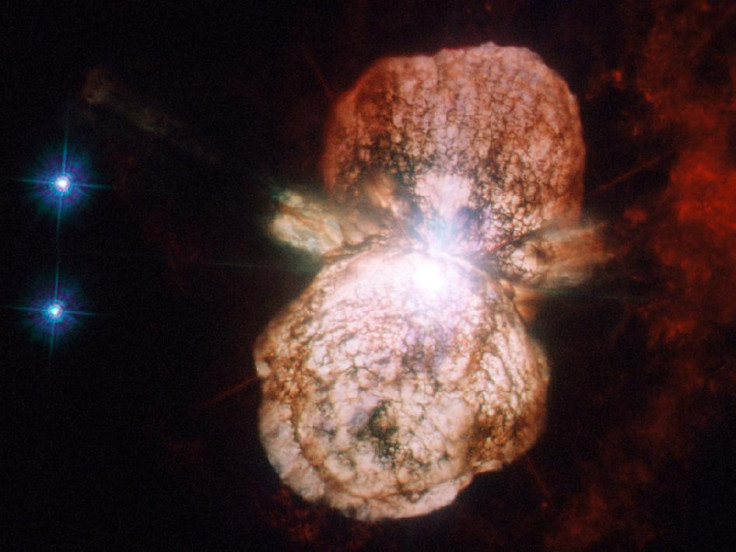Eta Carinae homunculus nebula has five 'death star' twins in other galaxies

Eta Carinae, the so-called "death star" 7,500 light years away that is about to explode, has five twins in nearby galaxies, scientists have discovered. Using Nasa's Spitzer and Hubble space telescopes, researchers spotted five objects with similar properties to the massive stellar system five million times brighter than our Sun.
Eta Carinae is known for an enormous eruption seen by astronomers between 1837 and 1856. During this time, it sent gas and dust amounting to 10 times the sun's mass into space. Composed of two stars orbiting each other, it is expected the pair will die at some point in the next million years – an event that will provide a huge stellar firework display that will be visible from Earth.
The system is the only one of its kind known in the Milky Way. However, scientists have now discovered Eta Carinae quintuplets. Since 2012, astronomers have searched for similar systems using a kind of optical and infrared fingerprint.
Krzysztof Stanek, a professor of astronomy at Ohio State University in Columbus, said: "We knew others were out there. It was really a matter of figuring out what to look for and of being persistent." And the persistence paid off. In a 2015 survey, they found two candidates located 15 million light years away in the galaxy M83, and another three located between 18 and 26 million light years away, with one in each NGC 6946, M101 and M51.
All five were found to mimic the properties of Eta Carinae in terms of their optical and infrared properties – they probably contain a high-mass star buried in up to 10 solar masses of gas and dust. The findings were published in The Astrophysical Journal Letters.
Stars like Eta Carinae produce huge amounts of chemical elements required for life, and eventually they explode as supernovae. Lead scientist Rubab Khan said: "The most massive stars are always rare, but they have tremendous impact on the chemical and physical evolution of their host galaxy."

The researchers say the discovery of these stars will help with our own understanding of Eta Carinae's huge eruption and how it relates to its evolution. With the launch of the James Webb Space Telescope, the team says they will be able to study these stars further. George Sonneborn, from Nasa's Goddard Space Flight Centre, said: "Combined with Webb's larger primary mirror, MIRI will enable astronomers to better study these rare stellar laboratories and to find additional sources in this fascinating phase of stellar evolution."
What will happen when Eta Carinae does explode is still a matter of debate. In a 2014 article, Scientific American noted it could wipe out life on Earth by releasing a huge gamma-ray burst – but that this scenario is highly unlikely. "According to a somewhat plausible worst-case scenario, a direct hit by an extremely bright GRB [gamma-ray burst] generated by Eta Carinae could devastate our planet in a manner similar to but far worse than full-scale thermonuclear war," the magazine noted.
"For several searing seconds, the planetary hemisphere facing the faraway star would be bathed in intense high-frequency radiation. The skies would fill with light much brighter than the sun, bright enough to ignite enormous continent-scouring wildfires on half the globe." The chances of this happening are, however, extremely remote.
© Copyright IBTimes 2025. All rights reserved.






















